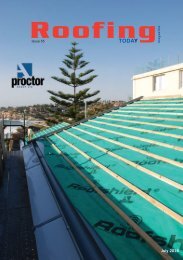Roofing
2kZ2j9o
2kZ2j9o
Create successful ePaper yourself
Turn your PDF publications into a flip-book with our unique Google optimized e-Paper software.
Regeneration<br />
Industrial <strong>Roofing</strong> - Bringing Buildings<br />
Back to Life<br />
By Janine Brady, Marketing Manager at SIG <strong>Roofing</strong><br />
Enquiry 1<br />
Above: A failing slate roof at Waterton Engineering, Chadderton, Manchester and (right) the roof is restored by over-roofing with 0.7mm thick box profiled sheet and GRP roof lights.<br />
Whether you are a large industrial roof and wall cladding specialist, or a<br />
small domestic contractor supplying and installing roofing components<br />
for one-off projects - industrial refurbishment offers multiple opportunities<br />
to expand your business and help develop under-utilised and outdated<br />
industrial and commercial properties.<br />
As towns and cities develop, old building stock naturally faces<br />
competition from newer buildings that are often more centrally located<br />
and meet all the latest building regulations. Take warehouses for<br />
instance: whilst many lie derelict, others remain empty or under-utilised<br />
as landlords fail to secure rentals due to the buildings’ appearance and<br />
overall amenities.<br />
Energy costs alone can prove challenging. By failing to achieve the<br />
minimum mandatory thermal performance level of 0,45Wm 2 K, a<br />
substantial fiscal energy wastage tax is levied. Equally, many outdated<br />
buildings are of single skin construction which can cause interstitial<br />
condensation. Not only is this unsatisfactory, it can present dangerous<br />
working conditions.<br />
By introducing roofing and wall cladding refurbishment solutions,<br />
commercial and industrial property owners can not only bring older<br />
buildings back to life, they can considerably extend their rental appeal<br />
Page 10 <strong>Roofing</strong> Today<br />
and their lifespan. In doing so, opportunities to re-market the buildings as<br />
alternative spaces emerge. Such solutions are often less costly than the<br />
demolition or redevelopment of the original structure, and they can<br />
significantly increase rental values and reduce future maintenance costs.<br />
Over-cladding and over-roofing are fast becoming popular refurbishment<br />
strategies to help overhaul existing industrial and commercial properties<br />
and can be conducted without much structural intervention to the building.<br />
Whilst they offer significant benefits over re-cladding and re-roofing, there<br />
are instances when the latter become essential. So, let’s take a closer look<br />
at the various options.<br />
Over-cladding or over-roofing: installing a new cladding system over the<br />
existing wall system of a building helps create a new façade bringing a<br />
new look to the building. Over-cladding the existing roof can take the form<br />
of erecting a new roof system over an existing empty space, such as an<br />
atrium, or on top of the existing roof. It could also mean introducing a longspan<br />
sky roof or glazing, or even a vertical extension of the building. As a<br />
result, demolition or disposal of the existing roof system is avoided. Not<br />
only do both techniques improve the external appearance of the building,<br />
they help reduce thermal heat losses and meet Part L2 Building<br />
Regulations. They can also prevent future deterioration and maintenance,<br />
as well as improve internal noise levels.<br />
Re-cladding or re-roofing: re-cladding the façade of a building usually involves replacing the<br />
existing wall system; this becomes preferable when the cost of over-cladding is exorbitantly<br />
high or is not feasible. Meanwhile, re-roofing usually refers to the stripping and laying of a new<br />
flat roof, or the re-tiling of a pitched roof, when the existing roof has failed. In the case of older<br />
buildings where asbestos may be present, re-cladding and/or re-roofing are the only options. In<br />
these instances, the building is deemed fragile and unsafe, and presents possible health and<br />
safety hazards. Combined with poor thermal properties and high air leakage, these structures<br />
command high insurance costs and are an unattractive rental proposition.<br />
By re-cladding or re-roofing with composite wall and<br />
roof panels, or site-assembled roof and walling,<br />
buildings can be completely transformed to provide<br />
an improved working environment. They offer longterm<br />
durability and improved lighting, together with<br />
reduced operating costs and enhanced rental appeal.<br />
Also, as well as complying with government<br />
legislation, a brand new roof also brings peace of<br />
mind with a guarantee of 25 years or more.<br />
Minefield<br />
Whether it’s over-cladding walls and roofs, or recladding,<br />
or re-roofing, choosing the right product or<br />
approach can be a minefield. Therefore, it pays to<br />
consult with an industrial roofing specialist who can<br />
offer advice on best practice and products/solutions;<br />
from roofing and sheeting, to insulation and roof<br />
lights, and fixings and fasteners. A one-stop expert<br />
will hold your hand every step of the way by<br />
providing a cohesive supply chain, and even arrange<br />
for training, if required.<br />
For those who are new to industrial refurbishment,<br />
every building is not necessarily a major project.<br />
Simply changing the roof lights can considerably<br />
increase light into the building and reduce energy<br />
costs.<br />
Equally, introducing gutter liners will help keep the<br />
building watertight without changing the entire<br />
gutter system. Whether new or experienced, the<br />
restoration of industrial and commercial properties<br />
can offer you multiple opportunities to expand your<br />
business. At the same time, it helps breathe new life<br />
back into outdated and under-utilised<br />
buildings.<br />
Page no. 11




